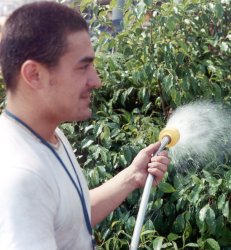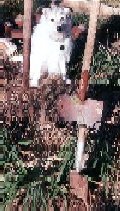Supplies, tools, structures, sculptures
Click on ads to support this site.
flower gifts for weddings and birthdays and mothers day

Watering with a water wand is a gentle way of hand watering with a hose. 
|
Hand watering is effective if
you have the time or only a few plants. A hose with watering wand works well.
|

|
If you can, pull down the pot. If you find a very dense ball of roots, the plant is root bound and won't do as well. Look for healthy roots that don't fill the pot completely. Plants that are just opening their buds are a better choice than those in full bloom the color will last longer. If a plant is showing fresh new growth (which is usually lighter in color), it is an indication of health. If a plant has been grown in too little light, the stems are elongated and the leaves are widely spaced. |
|
The first frost averages November 4. But those are just averages.In 1999, the killing frost didn't happen until November 24. The season can be extended by protecting plants on frosty nights. You can also start early by planting indoors in pots a few weeks before it is safe to put plants outside. Jiffy pots made of compressed peat moss are convenient way to start early. Put starting mix or potting soil in them, plant the seeds, water them, and set by a sunny window. When the plants reach four inches, set outdoors. The pot will rot and the roots will grow through it into the soil. Plants are rated by zone as to the winter cold they can with stand. Oklahoma City is in zone 7. Plants rated 1-7 should survive winters there. Check here for frost-free season: frost. |

|

Garden fork, spade, and trowel |
A rake can be used to level and smooth the bed. Carefully hand pull weeds that are close to a flower. Plant roots grow most easily in soil that is kept loose, they need air as well as water and soil. Sprays are also an option for weed control. |
|
Wood chips, grass clippings, leaves and pine needles make fine mulching materials. |
|
|
Most soils are either sandy or mostly clay. The best way to improve either is to add large amounts of organic material - manure and all that crap. It improves the fertility and helps hold moisture as well as making the soil easier to cultivate. |
Compost
is partially rotted material, manure, grass clippings, leaves, newspaper,
etc. You can buy bags of compost that contain no weed seeds from a garden
center or just make your own. A compost pile, usually about four feet by four, is a stack of organic material left to decompose. Keeping it slightly moist and mixing the pile monthly speeds the process. Expect it to take six months to a year. Mix the compost into the bed before planting. |

|
I tend to be a little more laidback. If a plant comes under constant attack, I tend to grow another type next year. I do launch a low scale guerrilla war by trying natural techniques, and occasionally I even try chemical attack. |